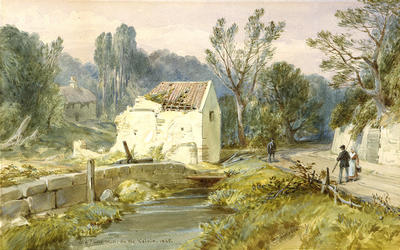
Old Flint Mill on the Kelvin, 1845 by William Simpson (1823-1899).
North Woodside Mill was a ruin in 1845 when Simpson completed the sketch on which this watercolour is based. In 1846 it was rebuilt as a flint mill for Kidston, Cochran & Co of the Verreville Glassworks. Imported flints were burned in a kiln at the mill until calcined and then placed in water and then ground in water to produce a think paste. The paste was then dried off and cut into blocks that were used in the manufacture of glass and the glazing of tiles, crockery and pottery. The mill was still in operation in 1934 when it was visited by the journalist James Cowan and sketched by Stuart Johnston. It was demolished in the 1960s but the ruins of the kiln, the weir and the lade survive and are preserved as features on the Kelvin Walkway.
The cottage just visible through the trees stands on the south bank of the river.
This watercolour is one of fifty-five painted by Simpson between 1893 and 1898. The series is based on sketches he completed fifty years earlier which appeared as black and white illustrations in Views and Notices of Glasgow in Former Times, published in 1848 by Allan & Ferguson.
Reference: 892am/ 1889.2.am
Reproduced with the permission of Glasgow City Council, Glasgow Museums
Keywords:
Allan & Ferguson, artists, Botanic Gardens, fishermen, fishing, flint mills, glass manufacturers, glass manufacturing, Kidston, Cochran & Co, North Woodside Mill, paintings, pottery manufacturers, pottery manufacturing, River Kelvin, ruins, watercolours, women
You have 0 images in your photo album.